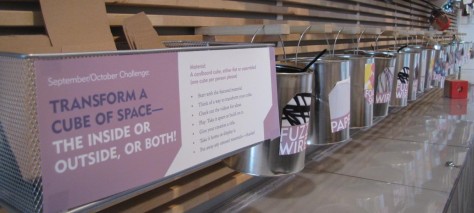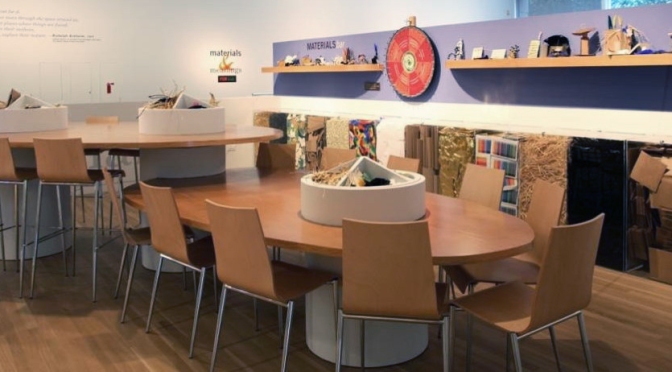Written by Jessica Fuentes, Center for Creative Connections (C3) Gallery Manager, Dallas Museum of Art
The creative process is often described as cyclical and sometimes, when I’m in it, it can feel like I am going around in circles, ending up where I started. Hopefully, when I come back around that circular process, my ideas have evolved so though I may be in a familiar place I am truly somewhere new. Perhaps the path of the creative process is then more like a spiral, repetitious yet constantly moving forward. This concept not only illustrates an important artistic process that we want to share with visitors to the Center for Creative Connections (C3) at the Dallas Museum of Art, but also it describes the methods we employ as our space evolves. The creative process is an inspirational component of C3 and it is exemplified through the Art Spot, a hands-on art making area.
A Brief History
In 2008, the hands-on art-making area within the C3 exhibition Materials and Meanings was called the Materials Bar. With a total of eighteen standard and tall seats, the space was designed as a communal area for visitors of all ages. The Materials Bar provided a hands-on experience of the creative process engaging visitors with an inspiration wheel, videos that modeled techniques, materials that encouraged play, and a reflective label writing component. The materials provided were similar to or related to works of art on view.

In 2010, C3 presented its second exhibition, Encountering Space, which involved a complete redesign of the entire C3 and transformed the Materials Bar into the Space Bar. Though it remained a hands-on making area, the focus on the new exhibition theme was evident in the inspirational prompts and reflective labels. Prompts challenged visitors to “transform a cube of space” or “build a sculpture with positive and negative space.” The label cards not only encouraged visitors to reflect, they also introduced vocabulary about space through a word bank. Additionally, the seating was expanded to accommodate twenty-six visitors.


In 2012, C3 transitioned away from themed exhibitions and towards a more fluid process of rotating works of art. Along with our process, the physical space changed, reflecting the end of Encountering Space and the beginning of a simplified graphic identity to reflect the DMA brand. With additional seating for a total of forty-four visitors, the area was renamed the Art Spot: Anytime art-making for everyone. Since then, we have experimented with different approaches. For a year we focused on one work of art, Family Portrait 1963 by Martin Delabano. Although we changed the materials and prompt every couple of months, they always related back to the work of art. The following year we explored the broader idea of creativity. We provided unconventional and everyday materials (like red plastic cups, spoons, paperclips, and twist ties) and challenged visitors to make something new and unexpected with them. More recently we have made connections between the Art Spot materials and our wall of visitor-submitted images with themes like Textual Awareness or Flowers.
Commonalities and Spiraling Forward
For me, the creative process can be simplified to four steps: inspiration, exploration, creation, and reflection. With each iteration of the making area in C3, we come full circle. We start with an idea—a theme like materials, space, or creativity— or a work of art. Next, we explore the possibilities of that idea and play with what it might look like. Then, we construct it for visitors to experience, and finally we reflect on the actual visitor experience. Over the years, the various iterations are in many ways similar, but with each new endeavor we learn and revise. In each iteration we were inspired by visitors, and hoped to inspire visitors — as art museum educators, we place an importance on encouraging visitors to connect with works of art. Furthermore, the area has always been about three-dimensional making and the creative process. In our upcoming redesign, we are sticking with these tenants, but are approaching them in different ways.
In the past we strived to inspire participants with the art on view in the Center for Creative Connections, though we found this can be difficult when the works of art are not directly adjacent to the making area. Often visitors come straight to the art-making area without looking at the works of art or, if they spend time looking at works of art, they may not be thinking of those objects when they arrive at the making area. When we installed Family Portrait 1963 directly in the Art Spot, we hoped that visitors would be more prone to draw inspiration from the work. We found that despite its positioning and large size, it quickly gets lost behind a sea of visitors when the Art Spot is full.

In the upcoming redesign, we are installing more works of art in the Art Spot and are strategically placing them near the tables where participants will be creating. Furthermore, the cases housing these works will have prompts directly on the glass to provoke thought and discussion about the materials, design, and process. These kinds of prompts can help visitors get into the making mindset, a way of critically looking at and exploring materials.
Also, our approach to choosing works of art has shifted. In the past we chose works of art that exemplified a concept and might inspire visitors to create. This time we are taking our inspiration from our visitors. Over the past few years we have documented the kinds of creations made at the Art Spot. We know that, regardless of the theme or materials, there are common items that are made: rings, animals, flowers, hats, and woven objects. So, we started with those observations and chose works of art that visitors might more easily relate to and that had some evidence of both the materials and the method of making.


Finally, we will continue to encourage the creation of three-dimensional objects, but rather than having one set of materials, we will offer different materials at different stations that relate to the nearby works of art. This will offer some variety so that visitors have more options.
Looking Ahead
When the Art Spot reopens in the next week, we will continue to ask for visitor input and revise, because being an experimental space means that we are constantly evolving through the creative process. We will document the creations visitors make; read the reflective statements they write; talk with them about the works of art, the materials, their creations, and their overall experience to get a sense of what aspects of the new design are working and what we may revise.
How Do You Do It? Share Your Thoughts
How would you describe your creative process?
How do your programs, activities, and gallery spaces change and evolve?
Share your thoughts with us in the comments section below, and let’s collectively reflect a bit more on our planning and reflection processes for these types of creative, experimental spaces in museums.


Great ideas ,and here’s a level 2 creative idea = building on an extant idea/work, see the Vietnam War Memorial by Maya Lin and the Iraq /Afanistan work the dude writing down all the combatants (US), on PBS TV, ..So ! how about and evolving Artwork that “tells”, the experience of visiting the DMA, my idea comes from the way some of my peops (Western Desert) Aboriginals depict country in an art work that IS the experience. just an (Antipodean thought bubble , keep up the creative evolution of DMA YMHS Ian
Sounds interesting Ian, I’d love to hear more about these Western Desert Aboriginals’ works.
Thank you for this thoughtful and clear picture of how your studio has evolved and functions with the focus on the visitors. Very inspiring.
Thanks Robyn!